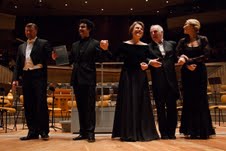by Sedgwick Clark
Gustavo Dudamel and the Los Angeles Philharmonic – America’s hottest orchestra/conductor team – breezed through New York last week for a pair of sold-out concerts they had just performed in LA, London, Lucerne, and Paris. Dudamel is a bona fide star. Now 32, he draws a younger-than-usual audience, and cheers erupted when he walked to the podium. But nothing in his demeanor indicates that this acclaim has gone to his head; he even appears bashful about it. True to his El Sistema upbringing, his commitment to music education is unwavering, and nothing in the American publicity mill will deter it. His conducting style is understated, with minimal gestures, and when the performance ends he walks through the orchestra to single out important soloists and entire choirs. He’s one of the gang, and he respects each and every one of them. He’s got the goods, and what’s happening on that other coast should be followed with great interest by the faltering music business.
He loves contemporary and 20th-century music, and all the works he conducted in New York fit that bill. Indeed, the first of the Lincoln Center concerts (3/27) was the local premiere of a single, extraordinarily ambitious work: John Adams’s oratorio The Gospel According to the Other Mary (2011-12). Many consider Adams a great composer, an opinion I wish I could share. His new work, lasting over two and a half hours, stretched the limits of boredom as few performances I can recall – not since Carlo Maria Giulini led this same orchestra in a full-hour, headache-inducing distention of Beethoven’s Eroica at Carnegie Hall 34 years ago.
For fuller, more gentlemanly analyses of the Other Mary, read George Loomis’s report (3/29) on the Musical America Web site and Anthony Tommasini’s in the Times (3/30). But even they were quite mixed over the sprawling structure of librettist and director Peter Sellars’s amalgam of poetry. Sellars is a brilliant thinker and talker, as he demonstrated once again in a pre-concert discussion, but noble ideas do not a viable libretto make, as this team so excruciatingly demonstrated with the opera Doctor Atomic. However, my concern here is about the musical element of the piece, not the political or religious matters – or Sellars’s distracting staging – that upset some of the reviewers I googled. I simply was not emotionally engaged by the way Adams arranged the notes.
The score is structured in two parts. The first part is the longest, and except for a couple of brief Orffisms I waited in vain for memorable melodic inspiration. The second half seemed to acquire a more angular rhythmic profile, perhaps because the deadline was encroaching and the motoric wisps of Stravinsky, Orff, and even Janáček that dot Adams’s earlier works asserted themselves more readily. (Tommasini heard “recognizeable inspirations, like big-band jazz, Bach, Copland, Ives, Ravel and more . . . .”) Whatever the case, Dudamel and the Angelinos acquitted themselves brilliantly as far as I could tell, and Deutsche Grammophon recorded the work in March.
Dudamel’s second concert (3/28) began with an ugly piece called Zipangu (1980), by Canadian composer Claude Vivier. According to the program book, Vivier’s “own style synthesized many characteristics of Debussy’s and Stravinsky’s music.” Nonsense.
The real music ensued with a rather soggy rendition of Debussy’s La Mer and a detailed and expressive (or, if one didn’t like it, slow and meandering) performance of Stravinsky’s complete Firebird (1910). While I prefer the greater intensity and drama of the composer’s recorded performance, which is tighter by five minutes, there were plenty of gorgeous moments to savor throughout the score in Dudamel’s conception, from the lovely “Round dance of the princesses” to the exciting “Infernal dance of Kastchei’s subjects,” which provoked applause at its wild conclusion.
An interesting detail: Stravinsky added two snarling trombone glissandi near the end of the Infernal dance in his 1919 Suite, which is the way the Firebird music is most often performed, and he retained it in his longer 1945 Suite. Neither the complete 1910 ballet music nor the 1910 Suite versions include the glissandi, but Dudamel added them (as well as, he told me later, other scoring details from the 1919 version that I didn’t notice), and they fit just fine. Why didn’t anyone else – including the composer himself ex post facto – think of this?
Looking Forward
My week’s scheduled concerts (8:00 p.m. unless otherwise noted):
4/4 Carnegie Hall. Boston Symphony/Daniele Gatti; Anne Sofie von Otter, mezzo; Tanglewood Festival Chorus. Mahler: Symphony No. 3.
4/5 at 7:00. Metropolitan Museum. New York Philharmonic Contact Concert/Alan Gilbert; Liang Wang, oboe. Unsuk Chin: Gougalon. Poul Ruders: Oboe Concerto. Anders Hillborg: Vaporized Tivoli. Yann Robin: Backdraft.
4/8 at 7:30. Symphony Space. Cutting Edge Concerts New Music Festival. Loadbang; Kathy Supove, piano; Oleg Dubson, actor. Alexandre Lundsqui: Gutteral I and II. Douglas Gibson: Fanfare for the Common Audience. Reiko Füting: Land of Silence. Andy Ahiko: LOVE LOST LUST LONE. Victoria Bond: The Page Turner. Hanna Lash: Stoned Prince.
4/11 at 7:30. Avery Fisher Hall. New York Philharmonic/David Robertson; Pierre-Laurent Aimard, piano. Messiaen: Les Offrandes oubliées. Mozart: Concerto No. 23. Tristan Murail: Le Désenchantement du monde. Beethoven: Symphony No. 2.
